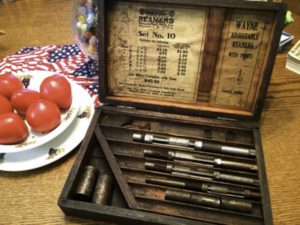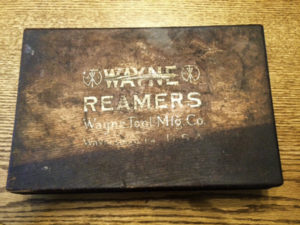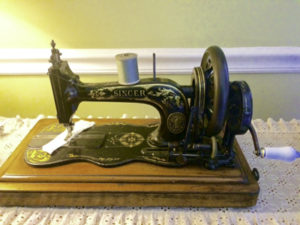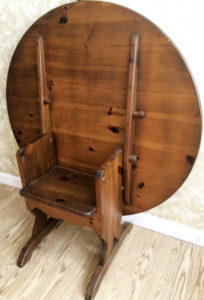by Lisa C. Cantwell
There were no questions submitted about trinkets or treasures this past month; so, my friend, Elaine Gladhill of Waynesboro, Pennsylvania, recently invited me to her home to view and research some of her collections. You never know what trinket or treasure may be gathering dust or rust around your den, attic, or shed. Take a second look and contact me at tomandlisa@wildblue.net, and I’ll feature your item(s) in a future article.
The first item Elaine showed me is a metal box of “Wayne Reamers” and is of regional interest.

 This set of tool accessories was a gift from a friend, who originally purchased it at auction from an old home in Waynesboro, Pennsylvania. The wooden box has clear lettering of “Wayne Tool Manufacturing Co.” printed on its lid, with a pasted paper insert list of reamer types and pricing. Wayne Tool was founded in 1917 as a maker and seller of reamers and drill bits, and is still in operation today. An extensive internet search did not reveal another Wayne Tool Manufacturing box like this one, complete with original products and prices. Similar boxes of other makers were valued between $14.00 and $62.00 on internet sale sites, but none were as old or as stocked with tools, nor did they have clear labeling. This box dates anywhere from 1917 through the 1920s, and is in very good condition! Its value would be in the $75 to $125 range, and possibly more, due to its rarity in the current market.
This set of tool accessories was a gift from a friend, who originally purchased it at auction from an old home in Waynesboro, Pennsylvania. The wooden box has clear lettering of “Wayne Tool Manufacturing Co.” printed on its lid, with a pasted paper insert list of reamer types and pricing. Wayne Tool was founded in 1917 as a maker and seller of reamers and drill bits, and is still in operation today. An extensive internet search did not reveal another Wayne Tool Manufacturing box like this one, complete with original products and prices. Similar boxes of other makers were valued between $14.00 and $62.00 on internet sale sites, but none were as old or as stocked with tools, nor did they have clear labeling. This box dates anywhere from 1917 through the 1920s, and is in very good condition! Its value would be in the $75 to $125 range, and possibly more, due to its rarity in the current market.
The second antique is a Singer hand-crank sewing machine, dated 1888.
 Elaine is a member of the Summit Stitchers, a sewing and quilting group that meets at the Blue Ridge Summit Library. She has used this little sewing machine to make beautiful creations. The needles are rare, so she keeps extras when she finds them. Her old portable Singer, imprinted “12k” on its base, is encased by the original oak cover and mounted on a fiddle-shaped base. It was originally marketed as the “Singer New Family Sewing Machine,” and in 1888 alone, over eight million were sold! “Singer” became a household name in America. Just as fascinating as this beautiful work of machinery is its inventor, Isaac Merrit Singer. As a child, he ran away from a troubled home and, literally, joined the carnival. He became a giant of a man, standing 6’5”. He fathered twenty-four children, and was one of the wealthiest men of the time.
Elaine is a member of the Summit Stitchers, a sewing and quilting group that meets at the Blue Ridge Summit Library. She has used this little sewing machine to make beautiful creations. The needles are rare, so she keeps extras when she finds them. Her old portable Singer, imprinted “12k” on its base, is encased by the original oak cover and mounted on a fiddle-shaped base. It was originally marketed as the “Singer New Family Sewing Machine,” and in 1888 alone, over eight million were sold! “Singer” became a household name in America. Just as fascinating as this beautiful work of machinery is its inventor, Isaac Merrit Singer. As a child, he ran away from a troubled home and, literally, joined the carnival. He became a giant of a man, standing 6’5”. He fathered twenty-four children, and was one of the wealthiest men of the time.
In addition to the Singer sewing machine, he invented a digger for rock excavation, a rock drilling machine, a wood-cutting and carving machine, and a printer’s type cutting machine. Internet research revealed that a Singer 12k brought $1,681 at auction in April 2011.
Elaine’s not planning on parting with her treasure that she bought at auction (for a much smaller amount)anytime soon.
The last item is a vintage chair table that sits in Elaine’s foyer.
 Of all the interesting and old things she showed me, including Civil War relics, antique furnishings and books, this table caught my eye because of its design. This style of table dates to 1620 and was in use by colonials and early settlers in the New England region until about 1780. Also known as a “chair hutch,” it was a space-saving, duo-purpose furnishing, made of available hardwoods, such as hickory, oak, and pine. The table simply flips forward and rests on the chair base. A painted version dating to the early 1700s had an asking price of $1,950 on one internet site. Reproductions that were made between 1900 and 1950, bring $260 to $400, depending on the craftsmanship and the maker. Chair tables are not being made en masse today by furniture companies, so they are difficult to find “new.” A search on a popular internet site yielded a new, handcrafted chair table with a square top by an independent craftsman. It’s cost was $975! Unique vintage furniture from the 20th century certainly has a following and is gaining value. Knowing which styles and makers are in demand gives buyers and sellers an edge in the market.
Of all the interesting and old things she showed me, including Civil War relics, antique furnishings and books, this table caught my eye because of its design. This style of table dates to 1620 and was in use by colonials and early settlers in the New England region until about 1780. Also known as a “chair hutch,” it was a space-saving, duo-purpose furnishing, made of available hardwoods, such as hickory, oak, and pine. The table simply flips forward and rests on the chair base. A painted version dating to the early 1700s had an asking price of $1,950 on one internet site. Reproductions that were made between 1900 and 1950, bring $260 to $400, depending on the craftsmanship and the maker. Chair tables are not being made en masse today by furniture companies, so they are difficult to find “new.” A search on a popular internet site yielded a new, handcrafted chair table with a square top by an independent craftsman. It’s cost was $975! Unique vintage furniture from the 20th century certainly has a following and is gaining value. Knowing which styles and makers are in demand gives buyers and sellers an edge in the market.

